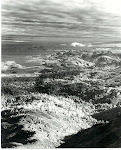Narratorium: Statement of Intent
a. Main TextStory forms community. Stories connect individuals. Without the sharing of stories, and human experience, people would have trouble relating to one another. This idea of trading stories seems to have been true since the beginning of human civilization. Neanderthals recorded stories and information through hieroglyphics, and more recent in time Native American tribes use story telling as a way to get across important social issues. Through communication is the only way to gain a community. The intent of my narratorium is that I want to gain a small community feel within a larger community like Portland. I want this building to create an opportunity for a casual storytelling happening as well as a somewhat formal sit-down event. Within these events a selection of recital areas would be needed to tell stories. The narratorium will have a certain flexibility in the recital areas to accommodate large and small groups. This should be a place to commune through the notion of storytelling.
An outdoor space that can be utilized for different reasons seems important to the full design of the building. It would act as a courtyard or a gathering area for the duration of the year. With the site being only a block away from the west park-blocks, I wanted to reply to the site in a similar language. The courtyard is a place where the public would get led into and then disperse from that point, like an outdoor lobby. During the dry seasons, the courtyard will act as an outdoor auditorium. An incorporation of indoor/outdoor opportunities is necessary because this site is in Portland and has high precipitation throughout most of the year. This space should be open to the public for free when there is no show happening. (Maybe free shows would be performed. Or maybe individuals volunteering to tell a story could involve the public.) When there is not a big show happening I see this place as a rich environment to go and eat on one’s lunch break. This outdoor space could possibly get the public more involved because it would spark curiosity for people to walk throughout the narratorium property without paying or going inside. With half of the site having this park-like atmosphere, hopefully it would draw in the community.
Moving inside the narratorium from the street or courtyard, the program brakes up in a more sporadic way. The first choice that one would come across is to either go down into the main building context or up to the more privatized space. Within this division space, the central circulation area splits the two general programs of the narratorium. I split storytelling into two forms: sharing and listening. If one enters the building then they are first introduced to the “sharing” side of the narratorium. This would act as the multipurpose story telling facility. This is more of the community space where several opportunities would arise for people sharing stories. If one were “going to listen” then they would visit the indoor or outdoor recital area to watch a story be performed. This space will be defined as the auditorium setting, which takes up most of the southern side of the building. The transition between the two program sides is captured as a café/bar/lounge, which allows people to mingle in between. The building needs this transition point because sharing and listening could not happen without one another.
There is a relationship between these two sides that could work really well together. After watching a perforance in the listening side one could cross the courtyard or café, and join the sharing side to talk about what they have seen or anything on their mind. Involved in the sharing would be a storytellers’ workshop that would be held in the general dwelling area. The storytellers’ workshop would be open to the general public. The public would hopefully get inspired by a storyteller’s performance and want to learn how to tell an interesting and compelling story. If they do not have much experience in the art of storytelling, then they can take a workshop.
The day-to-day schedule would be somewhere in between a movie theatre and a concert hall. I’m imagining several performances scheduled for one day. For the first half of the day (until 3pm), school groups would come and occupy the narratorium. Then when most of the public are getting of work, the narratorium would be open until 9pm for the general public. At least two or three shows would be going on at the same time. These shows would be intertwined, they would start and stop so that one story if anything is being performed. Then of course, there would be headliners and less popular storytellers. Within that experience, people would be introduced to less popular performers by just meandering to the main show.
The monthly and yearly schedule would be more similar to the concert hall because of the advertisement and preparation for each show. This building is certain to need tech support because of the sound systems that will be involved, and light. Lighting is necessary and maybe some sort of projector for PowerPoint presentations and light shows. I would imagine that the performers would come for a couple weeks to get a dramatic light show with the story. Having the performers come and stay for a few weeks would mean there would need to be a dwelling area. A short term dwelling or lodging seems necessary to get the performers to feel more comfortable in the narratorium. It would be just as easy to assign the performers a hotel room but they would not be as involved in the narratorium community.
b. Potent Sentence
Connecting a small community of storytellers to a larger community within the city of Portland.


1 comment:
This is all pretty stellar. Nice job.
Post a Comment